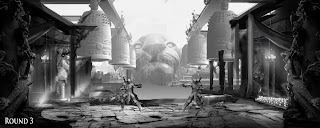THE
EMPTY SPACE
Student will explore the notion of “place” and design a stage set for a unique character.
Materials - 18" x 24" white paper, HB, 2B, 4B graphite pencils, kneaded eraser. Ink Marker Optional. Digital Optional.
Conceptual
This lecture will explore the notion of “place”. One of the foundations of architecture is how structure defines a site. Context is the identification of a real world geographic site (virtual or otherwise) for which architectural elements can establish an environment. Simply making buildings isn’t architecture. For architecture in games or film to be believable they must have context that is relatable to the human scale. Identifying space through the use of architectural elements space is enclosed, framed, positioned, adorned, and embellished with respect to focus, angles, openings, and light will ensure an expression of “place”. Architecture tells a story in how it identifies space so that it suggests ritual, ceremony, hierarchy, order, or transformation.
Student will explore the notion of “place” and design a stage set for a unique character.
Materials - 18" x 24" white paper, HB, 2B, 4B graphite pencils, kneaded eraser. Ink Marker Optional. Digital Optional.
Conceptual
This lecture will explore the notion of “place”. One of the foundations of architecture is how structure defines a site. Context is the identification of a real world geographic site (virtual or otherwise) for which architectural elements can establish an environment. Simply making buildings isn’t architecture. For architecture in games or film to be believable they must have context that is relatable to the human scale. Identifying space through the use of architectural elements space is enclosed, framed, positioned, adorned, and embellished with respect to focus, angles, openings, and light will ensure an expression of “place”. Architecture tells a story in how it identifies space so that it suggests ritual, ceremony, hierarchy, order, or transformation.
In games often a designer will reference a real
world location. The artist must research the site and create a “place”
ASSIGNMENT
The Stage
Practical
·
Create a drawing that identifies an
architectural idea of “place”
·
Examine real world reference
·
Identify a space for Conflict (A Fight, )
·
Establish space for an Intro and an
Outro
·
Define your “place” as Interior or Exterior with composition, form,
and proportions
·
Explore Depth and devices to encourage
a sense of atmosphere
·
Provide sketches of loose pages to
show design process
CHOOSE
a MUSE:
·
Sherlock Holmes
·
Santa Claus / Father Christmas
·
Leonardo Da Vinci
·
Ramses
·
Sam Spade
·
Scarecrow, Tin Man, or Cowardly Lion
·
Witch form Hansel and Gretel
·
Cowboy
EXPLORE:
·
Inspiration of the Stage
·
Stage Type: Open or Closed
·
Greebles
·
Lighting
·
Color
This assignment needs to be well designed and well rendered. It must be architectural and display architecture that is particular to muse and time period for the muse. It needs no figures but should convey clearly a sense of scale and "mise-en-scene (look up this term and apply it) Your stage should tell a story about for who this stage exists. I should be able to look at it and say "That's for so-and-so"
Homework
Complete: Assignment - “The Stage” 1 Drawing (Perspective) + support ideation or diagrams (Plan, Section)

























STUDENTS!!! IMPORTANT NOTE: If you plan on using your own muse PLEASE be sure to email me or reply to this comment with your chosen muse. Mr Bob.
ReplyDelete